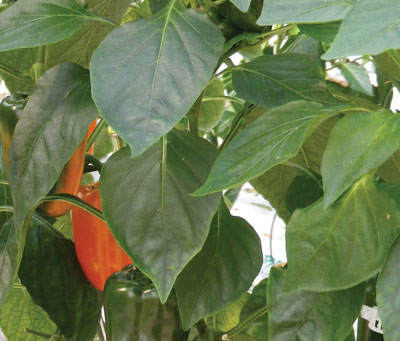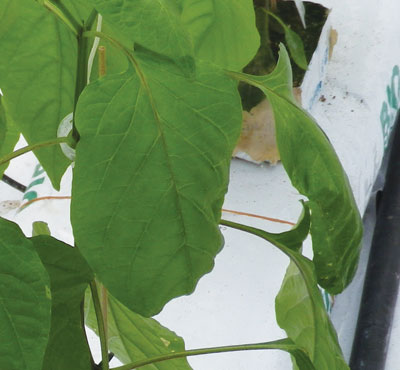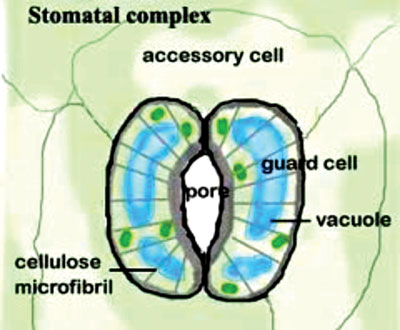
Features
Crops
Flowers
Growing Points: Understanding how plants work
September 25, 2012 By Dr. Mohyuddin Mirza
As mentioned in Part One in this series, the main business of plants we
grow for our sustenance is to take carbon dioxide from the air
As mentioned in Part One in this series, the main business of plants we grow for our sustenance is to take carbon dioxide from the air, combine it with water (which happens inside the leaves with green pigment chlorophyll around), and then add light. The end product is a wonderful product: glucose, and the release of oxygen.
 |
|
It appears to be a simple statement of facts, but there are actually many enzymes and other chemical reactions that are involved.
The interesting thing is that this glucose is further processed into complex storage products that we call carbohydrates. These are stored in the leaf cells. Once cells are packed with carbohydrates, photosynthesis slows down because there is no room to store them.
I tell growers to watch leaf colour in the morning and then again around noon. In the morning you will see a lighter green colour and by noon the colour becomes darker green. That is an indication that leaves have loaded up with food.
 |
|
If the leaves are still dark green in the morning, it usually means the plants have not processed their “food” during the nighttime or dark periods. The leaves become sluggish in photosynthesis the next day. The photosynthetic efficiency goes down and it will have negative consequences for fruit growth, root growth and new growth.
The picture on left side was taken at 4 p.m on a sunny day and right side was around 9 a.m. This shows that the leaves have used up the food stored during the previous night and are ready to start the photosynthesis process again.
A byproduct of photosynthesis is oxygen. I have often wondered about how much pure oxygen is produced by plants during the day in the greenhouse. This is my calculation and I take full responsibility for this. Five ml of pure oxygen is produced/hour/leaf. (I do not have any measurement of leaf area in millimetres.)
We human beings use 500 ml of air/breath and two breaths/second. When we breathe 500 ml of air, did you know that out of that, 78 per cent is nitrogen, 20.94 per cent is oxygen, 0.93 per cent is argon, and 0.039 per cent is carbon dioxide (not to mention other gases and pollutants)?
This means out of that 500 ml of air/breath, about 104 ml is pure oxygen. If there are 30 leaves on average per plant, then the amount of oxygen/hour will be around 150 ml per plant.
Now, here is another fact many growers don’t know; when I have asked them in workshops, they can only guess. What is the amount of carbon dioxide we exhale? You may be surprised that it is four per cent, that is, 40,000 parts per million (ppm). So, we breathe in 0.039 per cent carbon dioxide, and when we exhale it is four per cent. Plants love that extra, good quality carbon dioxide.
So, plants are happy when you work with them and you should be happy that you are getting free, good quality oxygen. Stay longer in the greenhouses and breathe deeply.
THE RESPIRATION PROCESS
■ Respiration is the opposite of photosynthesis, meaning that the food stored in the leaves during light hours as complex carbohydrates is broken down at night or during dark periods and converted back to the glucose molecule. This is then broken down to carbon dioxide and water. In this process, oxygen is used and water is produced as well. So the practical importance of this for the grower is that:
- Respiration is a cooler temperature process compared to daytime, and that is why you must know the night temperature requirement for your crops. Night temperature requirements change during different phases of plant growth.
Growers with advanced computerized controls can regulate night temperatures precisely, while I have seen growers with smaller greenhouses who just have a thermostat – they set the nighttime temperature when they leave for the day! This manual setup process causes many problems with crops due to higher respiration at warmer temperatures. I think these growers should invest in better temperature controls.
- Respiration requires oxygen and produces carbon dioxide and water. If you have forced air furnaces and don’t bring in fresh air for combustion, the furnace will compete with plants for that oxygen. I have seen situations where oxygen levels will drop from 20.8 per cent in normal air to below 19 per cent, and that is not good for plant health and human health. When furnaces and plants compete for oxygen, guess who wins? Furnaces always win and plants lose. So make sure that if you are using forced air furnaces enough fresh air is brought in closer to the furnace.
- Water is released during the respiration process and therefore relative humidity is higher at nighttime when compared to day time. If you don’t have a mechanism to get rid of this humidity, then the dew point can be reached and condensation will occur on the roof plastic and plants as well. Diseases like grey mold botrytis love this type of climate and crop losses can occur. Many growers have dehumidification systems installed and keep relative humidity under control.
- The carbon dioxide produced by the respiration process can be used by plants during the day. When new greenhouses are built on a piece of virgin land, carbon dioxide can also come from organic matter in the soil. Monitor levels of carbon dioxide at night, make sure the CO2 generators are off, and ensure that enough fresh air is available for combustion.
One other point to remember is that the chemical energy generated through respiration is channelled by the plant for root, fruit and top growth. How plants determine this partitioning of resources is a very interesting topic and research is continuing. We do know that 24-hour average temperatures have a big role to play in this portioning of resources.
Making plants vegetative or generative will be the subject of another article.
WHAT IS TRANSPIRATION?
■ Simply stated, transpiration is the process of the loss of water primarily from the surface of leaves but also to some extent from stems and fruits … basically from any exposed surface. It is an active process in which water is lost through openings on the leaf surface called stomata.

|
|
This illustration shows what stomata look like in plants we grow in greenhouses. It is important to understand the role and responsibilities of these openings. Here are a few facts you should know:
- The role of stomata is to open to let carbon dioxide get in, and to let oxygen and water out. During water stress situations, they close to conserve water.
- Stomata have to resolve several contradicting demands of water, carbon dioxide and humidity, among others. In order to open properly, they have to have enough water supplied from the roots and enough carbon dioxide around the leaf surface, and they have to take into consideration the high leaf temperature.
- With most greenhouse-grown plants, stomata are located mainly on the underside of the leaves. This is because the upper side is more exposed to light and wind and thus experiences more loss of water from the surface. The underside is more protected, meaning the stomata are not exposed to more loss of water.
Since most growers don’t have gadgets to help them see these stomata and determine when they open or close, here are a few management practices worth noting:
- Because the amount of water in the rootzone has direct links to stomata functionality, it is important that there be adequate water in the growing medium, especially in the early hours of the morning. The opening of stomata is triggered by light, but fully turgid guard cells around the hole are essential to open them, so enough water must be available.
- Potassium ions are involved in the opening and closing of guard cells, so make sure there is enough potassium in the feed solution.
- Carbon dioxide levels above 700 ppm can reduce the opening of stomata, so try to maintain proper levels in the greenhouse.
- Leaf temperature has a direct effect on the opening and closing of stomata. In order to conserve water, they will start closing but don’t shut down immediately. Enough water can be lost before they shut down. So try to control temperatures as close to recommendations as possible.
In Part Three in this series, I will talk about temperature, day and night, 24-hour average temperatures, and understanding moisture deficit.
Dr. Mohyuddin Mirza is a greenhouse consultant. • drmirzaconsultants@gmail.com
Print this page